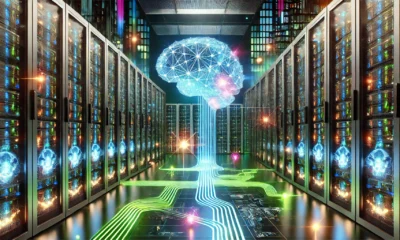AI 101
Synthetic Media – Types, Application, & Ethical Ramifications

Synthetic media came to popular attention for its ability to manipulate perception, especially via deep fake. However, it is more than just deep fakes. Synthetic media is any media generated using artificial intelligence, such as videos, pictures, sounds, texts, or virtual objects.
As more business execs incorporate the full potential of synthetic media, its use will dramatically transform various industries and applications, showcasing fantastic results. The Global Synthetic Media Market size was estimated at $1,7822 million in 2021 and is expected to reach $3,562,09 million by 2027, growing at a CAGR of 12.23%.
The article explores synthetic media, its various types, applications, and some ethical considerations for creating and using synthetic media.
What is Synthetic Media?
Synthetic media, more commonly known as AI-generated media, refers to digital media generated or manipulated using AI algorithms. It is a cutting-edge form of virtual content generated using AI technology. Synthetic media boasts a high level of realism and immersion, often making the content indistinguishable from real-world media.
It can be used for several purposes, including entertainment, advertising, journalism, and research. For example, the snack brand Lays used deepfake technology (deep learning + fake = deepfake) to enable football fans to send customized videos featuring Messi addressing their friends by name in a simple and intuitive video experience.
Main Types
Companies are increasingly investing in AI-driven content creation, tapping into the immense potential of synthetic media. Experts predict that by 2025, 90% of online content could be generated by AI. Let’s have a look at the 4 main forms.
1. Synthetic Text Generation
It refers to the use of artificial intelligence, including natural language processing (NLP), to generate written content, such as articles, news, stories, and social media posts.
For example, GPT 3 (Generative Pre-Trained Transformer 3) is a language model developed by OpenAI that can generate human-like text and answer your questions.
2. Synthetic Image Generation
Synthetic imaging is a computational method of generating 2D visual images using mathematical algorithms and data instead of the traditional photographic technique of capturing light waves using cameras or optics. The advancement of AI has made it possible to produce synthetic images with unparalleled realism. These images have captured significant attention, finding applications in a wide range of fields, from creating NFT art to generating realistic stock photos.
For example, modern films, such as Avatar, Star Wars, and Avengers, use computer-generated imagery (CGI) to create realistic worlds or add special effects that would be impossible to make in reality.
3. Synthetic Audio Generation
Synthetic audio generation is the process of generating audio that mimics human voice or the sound of musical instruments or altering original sounds using artificial intelligence. This is achieved using different techniques, such as text-to-speech (TTS) algorithms to convert text into audio or machine learning to generate new audio resembling existing audio patterns.
Synthetic audio generation has several applications, including virtual assistants, video games, and accessibility tools for people with disabilities. For example, users can use tools like Resemble.ai to clone voices in their digital avatars.
4. Synthetic Video Generation
Synthetic videos are types of videos created artificially using computer graphics. It simulates real-world scenarios and environments and can generate new or fictional videos. Its different applications include deepfake, digital avatars, and AI influencers.
Another type of synthetic video is face enactment, where a person controls the facial expressions of a target person. Another breakthrough in this technology is text-to-video generation. This has been made part of business discourse via tools like CogVideo – a text-to-video AI tool – on the back of text-to-image CogView2.
3 Real-World Synthetic Media Applications
Synthetic media can revolutionize multiple industries by opening up new possibilities and opportunities. Let's take a closer look at how it's impacting various sectors.
Entertainment Industry
The entertainment industry is where synthetic media is already making waves. This innovative technology is being utilized in virtual and augmented reality, as well as film and television production, to produce stunning visual effects and other captivating content.
Gaming Industry
The gaming industry has also seen a surge in the adoption of synthetic media. From generating realistic environments to creating non-playable characters (NPCs) and improving game graphics and audio, it enhances the gaming experience.
Business
AI chatbots and virtual assistants play a significant role in several industries, including e-commerce, medicine, banking, and real estate. It transforms how businesses approach customer service, sales, and communication while providing valuable data for marketing and advertising campaigns.
Education
Education is another field that benefits from synthetic media, as it has the potential to revolutionize the delivery and reception of education by providing students with more engaging and interactive learning experiences. Also, it can be used to create educational content in several languages, enabling the access of educational material to a wider audience.
Also, it is being used to develop an AI Teacher to help students with their work. For example, CodeBrainer has developed one, named Cobie AI, who can explain the content, follow students, and help them.
Synthetic Media – Ethical & Social Ramifications
There are many real-world scenarios where ethical and social implications arise. For instance:
- It can spread misinformation faster through deepfake audio and videos, causing harm to individuals and organizations.
- Privacy concerns can arise as synthetic media can create realistic impersonations of individuals without their consent.
- The adoption of synthetic media in certain industries could result in significant job losses, as machines can replace human labor in roles such as customer service and content creation.
- Organizations will create new jobs that combine human tasks with AI, leading to the need for upskilling the global workforce.
It’s critical to remain aware of the potential implications of this advanced technology and take steps to mitigate any negative impact it may have on society.
Synthetic Media: The Future of Digital Creation
Synthetic media is transforming the way we create and consume content. It is rapidly improving in terms of realism and ease of use and delivers fantastic results. With the advancements being driven in synthetic media, potential benefits can be numerous, including enhanced accessibility and the creation of more engaging content, as well as a personalized learning experience.
Stay updated on the latest trends in synthetic media and artificial intelligence with Unite.ai.












